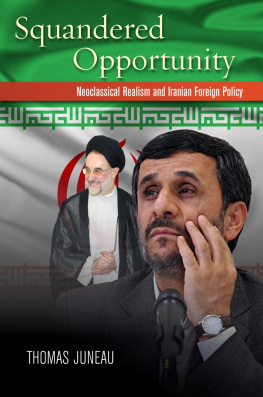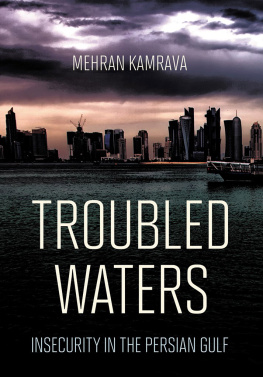CONTENTS
From the Provisional Government to the outbreak of war,
1979-1980
4 The 1990s: Gulf Crisis, islands dispute and President
Khatami
Relations in view of the Gulf Crisis, 1989-1992
Developments in the relationship under President Khatami
The Iranian idea of collective security in the Persian Gulf
The United States in the 1980s: from Carter to Reagan and Bush
vi
EXTERNAL FACTORS
The Persian Gulf policy of the Islamic Republic and its relations with its Arab neighbours were highly influenced by outside powers. The strategic importance of its large oil resources turned the Persian Gulf into one of the most internationalised regions in the world. The United States had always seen it as a Cold War arena and was intent on keeping the Soviet Union out. After the Gulf Crisis in 1990-1991 and the fall of the Soviet Union, the United States saw the threat as emanating from Iran and Iraq and expanded its military presence in the region. The Arab states became increasingly dependent on this one remaining superpower. The Europeans as well were interested in maintaining the security of the region, as their dependence on Persian Gulf oil was far higher than that of the Americans. They also competed for trade and arms sales.
These outside forces have restricted Iranian influence and relations in the region. The Islamic Republic of Iran saw the United States as its principal enemy and the main source of friction in the region. This was based on the US military presence in the Persian Gulf in the 1980s, and in particular in the 1990s, but stemmed originally from Khomeinis opposition to the Shahs alliance with the United States and his view of the Great Satan. He maintained that both the United States and the Soviet Union wanted to dominate the Middle East and that Islamic Iran had to lead the oppressed masses against these arrogant powers. During the Iran-Iraq war, Iran attempted to find an equilibrium between the two superpowers. After the fall of the Soviet Union, Iran tried to counterbalance American pressure with Russia and the Europeans. This chapter examines the United States - and with it the Soviet Union - and European influence in the Persian Gulf. Finally, it investigates whether the outside influence on the GCC states in turn had any effect on Iranian policy towards the Gulf countries.
The United States in the 1980s: from Carter to Reagan and Bush
In the 1980s, the United States managed to establish itself in the Persian Gulf. It created a US security umbrella reaching from Oman to Saudi Arabia.
In 1980, Oman signed a facilities arrangement for contingency bases with the United States. As stated by the Secretary General of the Omani Foreign Ministry, H.H. Sayyid Haitham bin Tariq Al Bu Sa'id:
We have very good relations with the United States. We signed the facilities arrangement in 1980 because we saw the structural weakness of the region. At that time the Soviet Union occupied Afghanistan and was reaching for the region.1
The US Middle East Force was home ported in Bahrain where it had been based since 1949. Kuwait allowed the US to deploy an offshore base in its territorial waters in late 1987. Saudi bases like Dhahran and Hafr al-Batin were offered for American use in emergencies. The Saudis deployed E-3A AWACS planes and other American forces on their soil during the war. Further, the Saudi reliance on US equipment led to joint operations with US forces.2 This military strategy of expanding influence in the region was underlined by security assistance and massive arms sales to the Arab governments. In 1987, President Ronald Reagan stated:
The use of the vital sea lanes of the Persian Gulf will not be dictated by the Iranians. These lanes will not be allowed to come under control of the Soviet Union. I will not permit the Middle East to become a choke point for freedom nor a tinderbox of international conflict.3
Iran perceived all this as a major threat to its security. The fear of the Soviet Union gaining influence in the Persian Gulf was the main driving force behind American Gulf policy in the 1980s, as was the fight against communism on a global scale. This policy, as stated by a US State Department official, was linked to securing the free flow of oil at reasonable prices, freedom of navigation and the support of the friendly Arab regimes in the area. He added that the main regional threat was Iran because of the policy of its government, Iranian society, and the pride that comes with being Iranian.4 The fear of export of the revolution which would lead to unfriendly regimes ruling over the oil resources, possibly opening these countries to Soviet domination, was a major concern of the US administration as it would mean the end of the American presence in the region, as well as a possible threat to the state of Israel. As the former US official James Noyes put it:
The Saudi position in Islam as guardian of the holy places... is important within the longer perception of Islam as a basic ally of the West against Soviet expansion. Iranian efforts to topple the Saudi regime during the pilgrimage of 1987 by riots reveals the potential importance of these holy places in a political context. Imagine the impact of a Saudi government which instead of arresting pilgrims carrying weapons and subversive propaganda, exploited the pilgrimage institution by sending weapons and subversion back home with the million-plus Muslim visitors each year.5
Many American officials, like Noyes, out of fear of unfriendly regimes taking over the region, misinterpreted the 1987 hajj incident as an attempt to topple the Saudi regime.
The rise of American influence began towards the end of the first year of the revolution, in 1979. In October, the United States admitted the Shah for medical treatment. James Bill calls this the most catastrophic miscalculation which led directly to a new era in Iranian-American relations - an era dominated by extremism, distrust, hatred and violence.6 In November, the US Embassy was occupied by the Students of the Imams Line. The US Ambassador and staff had been taken captive previously in February, but Foreign Minister Ibrahim Yazdi and other members of Khomeinis entourage had intervened and released them within twenty-four hours.7 In November, Khomeini personally endorsed the move, as he accepted it as the divine will against the oppressor nation,8 and they remained hostage for 444 days. The psychological effect of the whole episode has influenced US policy towards Iran ever since. Many Democrats blamed it for the loss of the presidential election that year.
In December 1979, the Soviet Union moved troops into Afghanistan, which was seen in Washington as a first step towards the warm waters of the Indian Ocean and Persian Gulf oil. The American reaction, which was in line with the idea of setting up Rapid Deployment Forces in the Middle East, was announced on 23 January 1980, with the Carter Doctrine:
Let our position be absolutely clear. An attempt by any outside force to gain control of the Persian Gulf region will be regarded as an assault on the vital interests of the United States of America, and such an assault will be repelled by any means necessary, including military force.9
Carter had already deployed a small force in Saudi Arabia and the Indian Ocean in January and March 1979, and had sent the US navy ship Kitty Hawk to the Arabian Sea after the hostage taking in November. By January 1980, the US had deployed a more powerful force than later during the tanker war in 1987-1988. Besides AWACS stationed in Saudi Arabia and B-52 bombers which overflew the Arabian Sea, the navy had sent twenty-five ships, including three aircraft carriers to the Indian Ocean.10 By October, the figure had gone up to thirty-two.11 This was the beginning of the direct American presence in the region. The Soviet reaction was the repetition of earlier proposals to demilitarise the Persian Gulf and Indian Ocean. In December 1980, Brezhnev rejected the justification of an alleged Soviet threat to the regions oil wealth for the US military build up. But he declared: We are not indifferent to what takes place in this region, which is so close to our borders.12 This stance only reinforced the American attitude.
Next page









